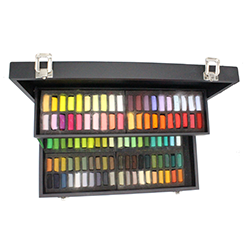Soft pastels
home| hard pastels| soft pastels| pastel pencils| oil pastels| water pastels
Soft pastels
The basic ingredients of pastels are ground pigments and a binder that holds the pigment particles together. They are mixed to form a stiff paste, which is then compressed into round‑ or square‑ sectioned sticks and allowed to dry. Soft pastels have a high proportion of pigment to binder, hence the ease with which they transfer colour to the support and the brilliance and rich texture of the colours. Soft pastels may also include white chalk, or a similar filler, which gives luminosity to bright hues and pale tints.The colour ranges vary with the manufacturer, and there is no standard identification of the pigments. Some of the high‑quality pastel ranges have literally hundreds of colours, including pure hues together with lighter and darker tones of each individual hue _ these may be identified by numerical codes that signify related colour values. This abundance of colours acknowledges the directness of pastel as a painting medium ‑ deprived of the ability to mix colours infinitely as you can with paint, you are offered a palette of pastels that would enable you to vary the colour of every stroke. Other good brands provide slightly less colour variation, but all are likely to meet your requirements more than adequately.
The loose, grainy texture of soft pastels provides great colour clarity, but it is also the reason why many people find pastels difficult to use. The powdery colour can seem to spread uncontrollably, and it is aggravating when a fragile pastel stick snaps or crumbles in the middle of a stroke. This can lead to a cautious approach, but the best results come from working freely and decisively.
